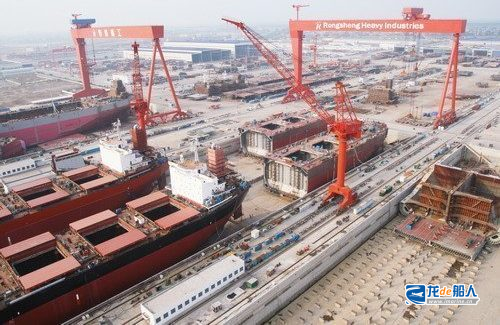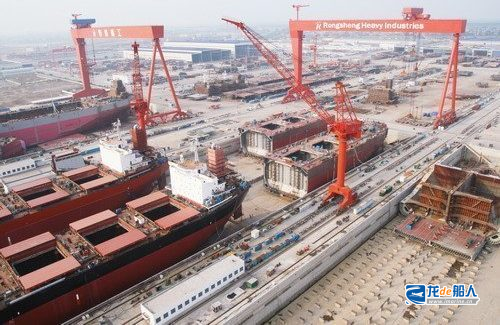Gianluigi Aponte’s Mediterranean Shipping Company (MSC) is said to have brought what was China’s biggest private shipbuilder back from the dead with a large container ship newbuilding deal, sending “shock waves” through the market and raising questions over its future according to Trade Winds.

MSC has inked a contract with previously defunct Jiangsu Rongsheng Heavy Industries for 8 LNG dual-fuelled 11,000-teu container ships, with options for four more ships of the same type. If the order goes into effect, it will be the first commercial ship order received by Rongsheng Heavy Industries in nearly 10 years since it stopped production in 2015, and it will also be its first time to build a dual-fuel LNG ship.
Ship brokers pointed out that the current construction cost of this type of LNG dual-fuel container ship is about US$170 million each, and the total price of 12 ships will be as high as US$2.04 billion (about RMB 14.533 billion). They believe that MSC may enjoy a large discount on this shipbuilding contract with Rongsheng Heavy Industries.
As early as August this year, there were reports that Rongsheng Heavy Industries was about to restart. According to ship broker MB Shipbrokers (formerly Maersk Broker), Rongsheng Heavy Industries has obtained financial support and signed a series of 12,000TEU liquefied natural gas (LNG) dual-fuel powered containership orders with MSC, the world’s largest container shipping company.
As early as 2022, there was news in the industry that Rongsheng Heavy Industries was accepting new ship orders and hoped to restart its shipbuilding business. In May 2022, mining giant Vale announced its plan to build 14 300,000 DWT dual-fuel very large ore carriers (VLOCs), and said it was in contact with several Chinese shipyards including Rongsheng Heavy Industries; in November, Rongsheng Heavy Industries was reported to be renamed SPS Shipyard and signed a letter of intent (LOI) with a subsidiary of Greek shipowner George Economou to build 10 bulk carriers of two types. However, according to news at that time, due to the large amount of funds, Rongsheng Heavy Industries did not make much progress in its restart.
In its heyday, Rongsheng Heavy Industries had 4 large docks equipped with 6 sets of 900-ton gantry cranes, 1 set of 600-ton gantry crane and 1 set of 1,600-ton gantry crane, which was the largest in China at that time. It has 8 outfitting wharves and 2 material wharves, together with supporting modern facilities and equipments such as steel plate pre-treatment workshop, component factory, flat and curved section workshop, pipe manufacturing workshop, coating workshop, etc. The designed annual shipbuilding capacity is 8 million DWT. Rongsheng Heavy Industries’ No. 1 to No. 3 docks were completed between 2005 and 2009, and No. 4 dock was put into operation in 2011.
Clarksons data shows that the last ship built by Rongsheng Heavy Industries was delivered in 2017. From 2008 to 2017, Rongsheng Heavy Industries delivered a total of 94 ships, including 16 400,000 DWT VLOCs.

Since the beginning of this year, MSC has placed orders for 52 new LNG dual-fuel ships at several shipyards in China, with a total amount of US$10.4 billion, including 10 21,000TEU ships from Jiangsu Hantong Ship Heavy Industry Co., Ltd (HT), 12 19,000TEU ships from Zhoushan Changhong International, 6 19,000TEU ships from Shanghai Waigaoqiao Shipbuilding (SWS), 8+4 11,500TEU ships from Penglai Zhongbai Jinglu Ship Industry Co., Ltd. (Jinglu Shipyard) and 10+4 21,000TEU ships from Hengli Heavy Industry.
The latest top 100 ranking released by shipping analysis agency Alphaliner shows that as the world’s largest container shipping company, MSC currently owns 868 ships, including 575 owned ships, with a total capacity of 6.19 million TEUs.
MSC has been a strong advocate of using LNG as a marine fuel in order to fulfill its commitment to achieve net zero emissions by 2050. The company’s CEO Soren Toft said that MSC’s fleet renewal strategy includes 100 dual-fuel ships. At the same time, MSC has joined the SEA LNG Alliance, aiming to explore bio-LNG (especially renewable synthetic LNG) in collaboration with the organization.


